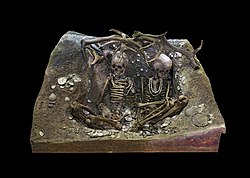Portal:Paleontology
|
The Palaeontology Portal
Introduction Paleontology or palaeontology is the scientific study of the life of the past, mainly but not exclusively through the study of fossils. Paleontologists use fossils as a means to classify organisms, measure geologic time, and assess the interactions between prehistoric organisms and their natural environment. While paleontological observations are known from at least the 6th century BC, the foundation of paleontology as a science dates back to the work of Georges Cuvier in 1796. Cuvier demonstrated evidence for the concept of extinction and how life of the past was not necessarily the same as that of the present. The field developed rapidly over the course of the following decades, and the French word paléontologie was introduced for the study in 1822, which was derived from the Ancient Greek word for 'ancient' and words describing relatedness and a field of study. Further advances in the field accompanied the work of Charles Darwin who popularized the concept of evolution. Together, evolution and extinction can be understood as complementary processes which shaped the history of life. Paleontology overlaps the most with the fields of geology and biology. It draws on technology and analysis of a wide range of sciences to apply them to the study of life and environments of the past, particularly for the subdisciplines of paleobiology and paleoecology that are analogous to biology and ecology. Paleontology also contributes to other sciences, being utilized for biostratigraphy to reconstruct the geologic time scale of Earth, or in studies on extinction to establish both external and internal factors that can lead to the disappearance of a species. Much of the history of life is now better understood because of advances in paleontology and the increase of interdisciplinary studies. Several improvements in understanding have occurred from the introduction of theoretical analysis to paleontology in the 1950s and 1960s that led to the rise of more focused fields of paleontology that assess the changing geography and climate of Earth, the phylogenetic relationships between different species, and the analysis of how fossilization occurs and what biases can impact the quality of the fossil record. (Full article...) Selected article on the prehistoric world and its legacies
Tyrannosauridae (or tyrannosaurids, meaning "tyrant lizards") is a family of coelurosaurian theropod dinosaurs which comprises two subfamilies containing up to eleven genera, including the eponymous Tyrannosaurus. The exact number of genera is controversial, with some experts recognizing as few as three. All of these animals lived near the end of the Cretaceous Period and their fossils have been found only in North America and Asia.
Although descended from smaller ancestors, tyrannosaurids were almost always the largest predators in their respective ecosystems, putting them at the apex of the food chain. The largest species was Tyrannosaurus rex, one of the largest known land predators, which measured up to 12.3 metres (40 ft) in length and up to 6,500 kilograms (7.2 short tons) in weight. Tyrannosaurids were bipedal carnivores with massive skulls filled with large teeth. Despite their large size, their legs were long and proportioned for fast movement. In contrast, their arms were very small, bearing only two functional digits. Unlike most other groups of dinosaurs, very complete remains have been discovered for most known tyrannosaurids. This has allowed a variety of research into their biology. Scientific studies have focused on their ontogeny, biomechanics and ecology, among other subjects. Soft tissue, both fossilized and intact, has been reported from one specimen of Tyrannosaurus rex. (see more...) Did you know?

General images -The following are images from various paleontology-related articles on Wikipedia.
Selected article on paleontology in human science, culture and economics
Cultural depictions of dinosaurs have been numerous since the word dinosaur was coined in 1842. The dinosaurs featured in books, films, television programs, artwork, and other media have been used for both education and entertainment. The depictions range from the realistic, as in the television documentaries of the 1990s and first decade of the 21st century, or the fantastic, as in the monster movies of the 1950s and 1960s.
The growth in interest in dinosaurs since the Dinosaur Renaissance has been accompanied by depictions made by artists working with ideas at the leading edge of dinosaur science, presenting lively dinosaurs and feathered dinosaurs as these concepts were first being considered. Cultural depictions of dinosaurs have been an important means of translating scientific discoveries to the public. Cultural depictions have also created or reinforced misconceptions about dinosaurs and other prehistoric animals, such as inaccurately and anachronistically portraying a sort of "prehistoric world" where many kinds of extinct animals (from the Permian animal Dimetrodon to mammoths and cavemen) lived together, and dinosaurs living lives of constant combat. Other misconceptions reinforced by cultural depictions came from a scientific consensus that has now been overturned, such as the alternate usage of dinosaur to describe something that is maladapted or obsolete, or dinosaurs as slow and unintelligent. (see more...) On this day...Selected image
CategoriesTopicsGeneral - Paleontology - Fossil - Evolution - Extinction Quality ContentFeatured paleontology articles
- Achelousaurus
- Acrocanthosaurus
- Albertosaurus
- Allosaurus
- Amargasaurus
- Ankylosaurus
- Apatosaurus
- Archaeopteryx
- Baryonyx
- Carnotaurus
- Catopsbaatar
- Ceratosaurus
- Chicxulub Crater
- Compsognathus
- Cretaceous–Tertiary extinction event
- Daspletosaurus
- Deinocheirus
- Deinonychus
- Deinosuchus
- Dilophosaurus
- Dinosaur
- Diplodocus
- Dromaeosauroides
- Edmontosaurus
- Elasmosaurus
- Giganotosaurus
- Gorgosaurus
- Herrerasaurus
- Iguanodon
- Istiodactylus
- Lambeosaurus
- List of dinosaur genera
- Majungasaurus
- Massospondylus
- Megalodon
- Nemegtomaia
- Nigersaurus
- Opisthocoelicaudia
- Paranthodon
- Parasaurolophus
- Plateosaurus
- Psittacosaurus
- Seorsumuscardinus
- Spinosaurus
- Stegosaurus
- Stegoceras
- Styracosaurus
- Tarbosaurus
- Thescelosaurus
- Triceratops
- Tyrannosaurus
- Velociraptor
Things you can doCurrent Paleontology FACs - None yet... WikiProjectsRelated portalsAssociated WikimediaThe following Wikimedia Foundation sister projects provide more on this subject:
Discover Wikipedia using portals |































